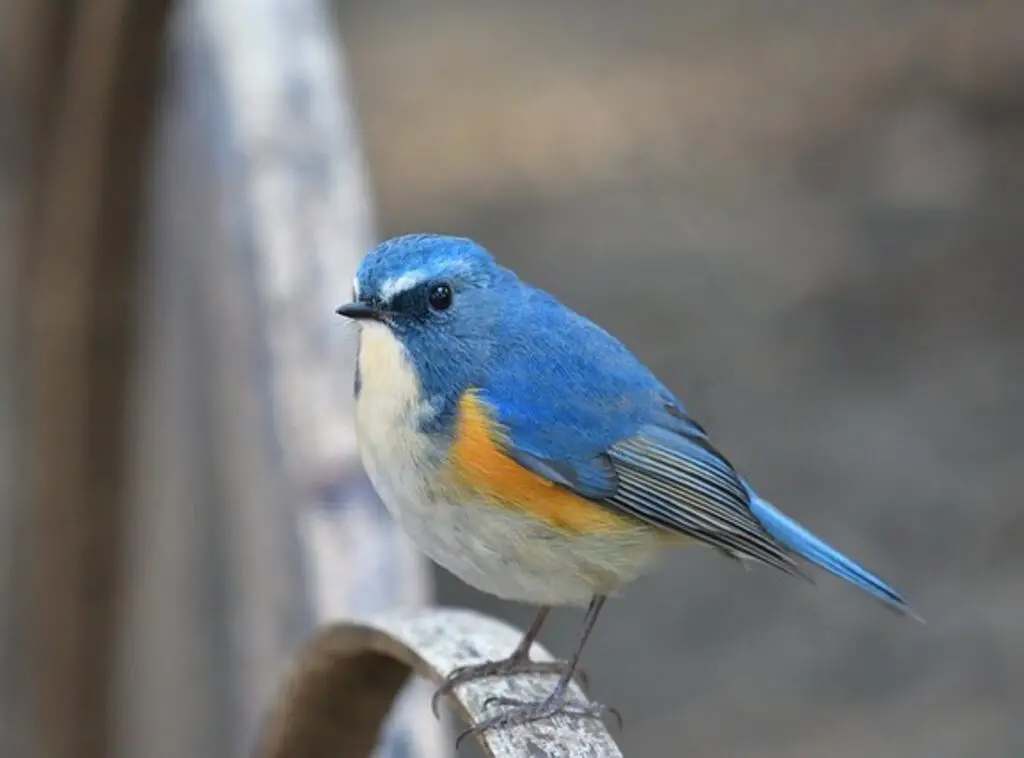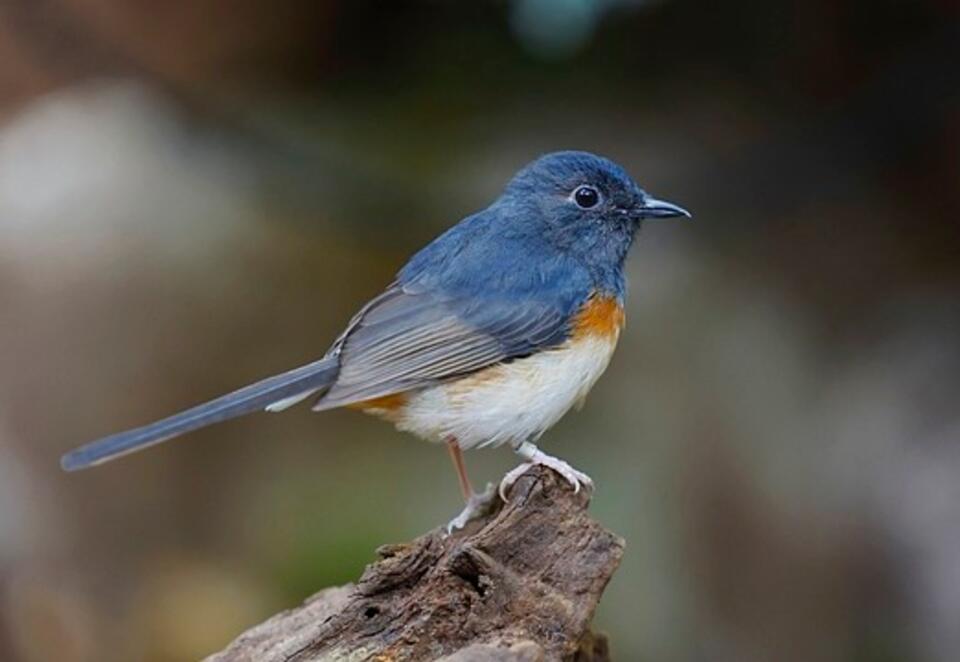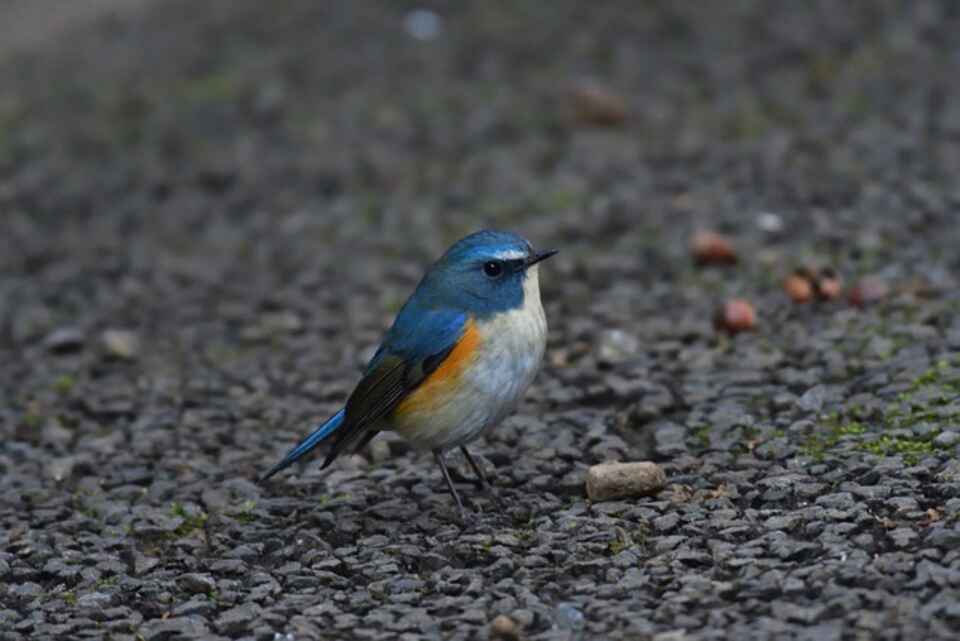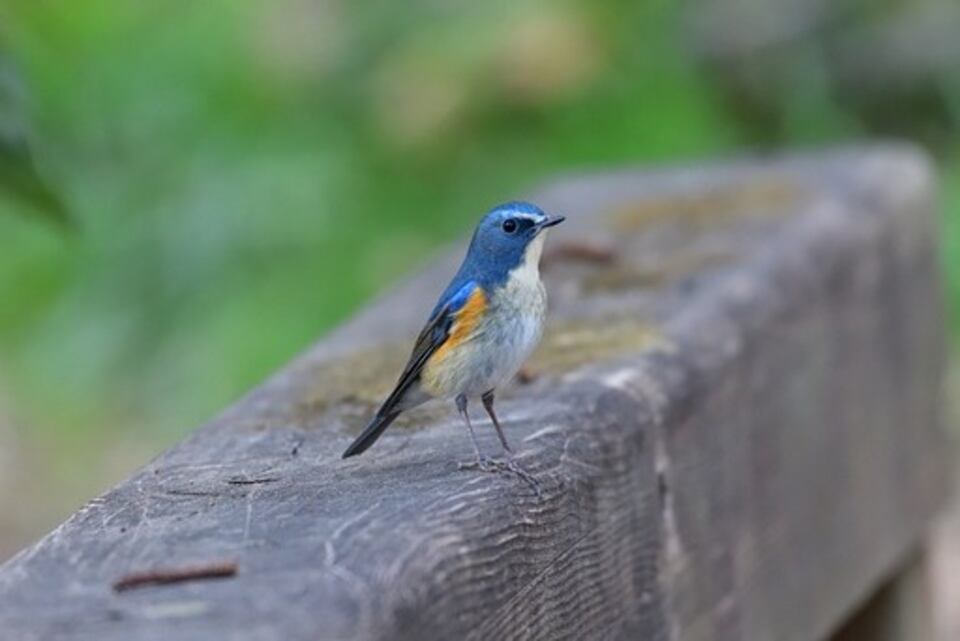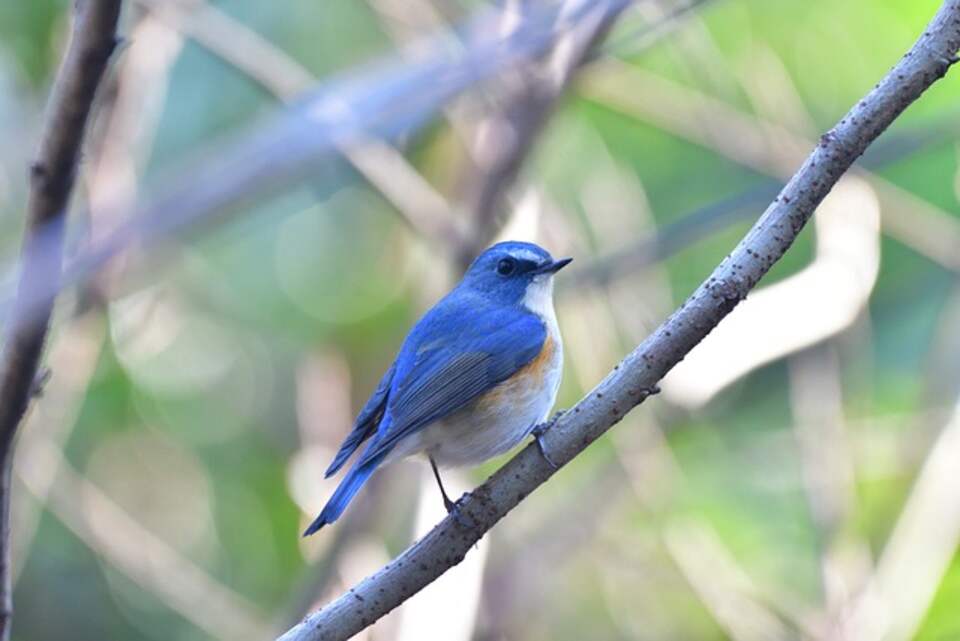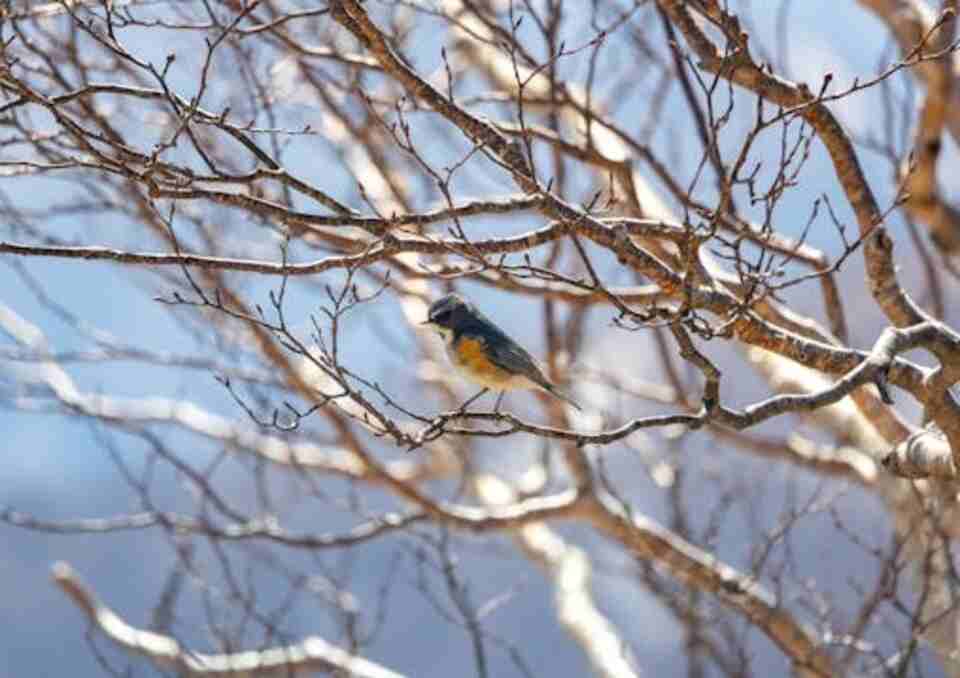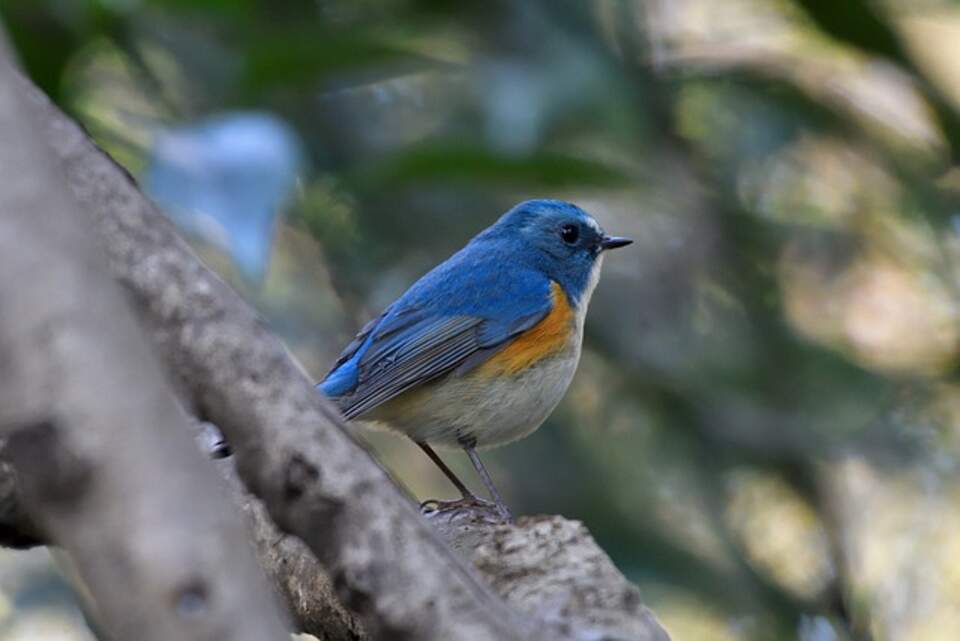The Red-flanked Bluetail (Tarsiger cyanurus) is a small, captivating bird that has fascinated ornithologists and bird enthusiasts alike for generations. Known for its striking blue tail and distinctive orange flanks, this species is a jewel of the avian world.
In this comprehensive guide, we’ll explore every aspect of the Red-flanked Bluetail, from its physical characteristics to its conservation status, providing you with all the essential information you need to understand and appreciate this remarkable bird.
Table of Contents
Physical Characteristics
The Red-flanked Bluetail is a small passerine bird, measuring approximately 13-14 cm (5.1-5.5 inches) in length and weighing between 10-18 grams (0.35-0.63 ounces). As its name suggests, this bird is most notable for two distinctive features: its vibrant blue tail and the striking orange-red coloration on its flanks.
Plumage
The plumage of the Red-flanked Bluetail varies between males, females, and juveniles:
- Adult Males: The most colorful of the species, adult males display a bright blue upperparts, including the crown, nape, back, and tail. The throat and breast are a soft orange-buff color, fading to white on the belly. The namesake orange-red flanks are particularly vivid during the breeding season.
- Adult Females: Females are more subdued in coloration, with olive-brown upperparts and a blue-tinged rump and tail. Their underparts are pale buff, and the orange flanks are less pronounced than in males.
- Juveniles: Young Red-flanked Bluetails resemble females but have spotted upperparts and lack the blue tones in the tail and rump.
Other Physical Features
- Bill: The bill is short, thin, and black, perfectly adapted for catching insects.
- Eyes: Large and dark, giving the bird an alert and curious appearance.
- Legs: Slender and dark brown to black in color.
- Wings: Relatively short and rounded, adapted for maneuvering through dense vegetation.
Seasonal Changes
Like many bird species, the Red-flanked Bluetail’s plumage can vary slightly with the seasons. During the breeding season, males’ colors become more intense, particularly the blue and orange hues, to attract mates and establish territories.
Here’s a structured table for the information:
| Feature | Male | Female | Juvenile |
|---|---|---|---|
| Upperparts | Bright blue | Olive-brown | Spotted olive-brown |
| Tail | Vivid blue | Blue-tinged | Slightly blue-tinged |
| Throat/Breast | Orange-buff | Pale buff | Pale buff with spots |
| Flanks | Vibrant orange-red | Subtle orange | Lacking orange |
| Bill color | Black | Black | Black |
| Eye color | Dark | Dark | Dark |
Habitat and Distribution
The Red-flanked Bluetail is a widespread species with a fascinating distribution pattern that spans across much of Asia and reaches into parts of Europe.
Geographic Range
The breeding range of the Red-flanked Bluetail primarily covers:
- Northern Asia: From the Ural Mountains eastward across Siberia
- Russian Far East
- Northern Japan (Hokkaido)
- Parts of China, particularly in mountainous regions
During winter, these birds migrate southward, with wintering grounds including:
- Southern China
- Taiwan
- Southeast Asian countries like Vietnam, Laos, and Thailand
- Parts of the Indian subcontinent
Interestingly, in recent decades, there has been an expansion of the breeding range westward into parts of Finland and occasionally other Scandinavian countries.
Preferred Habitats
The Red-flanked Bluetail shows a preference for specific habitats, which can vary slightly between its breeding and wintering grounds:
Breeding Habitats:
- Coniferous and mixed forests
- Taiga (boreal forest)
- Mountain forests, particularly at elevations between 1,000-2,500 meters
- Areas with dense understory vegetation
- Forest edges and clearings
Wintering Habitats:
- Lowland forests
- Secondary growth woodlands
- Bamboo thickets
- Parks and gardens in urban areas
Habitat Requirements
Several key features make a habitat suitable for Red-flanked Bluetails:
- Dense Understory: These birds prefer areas with thick ground cover, which provides protection and foraging opportunities.
- Vertical Structure: A mix of ground level vegetation, shrubs, and taller trees is ideal.
- Water Sources: Proximity to streams or other water bodies is often preferred.
- Fallen Logs and Debris: These provide excellent foraging sites for insects.
- Cool, Humid Climate: Especially important in breeding areas.
Migration Patterns
The Red-flanked Bluetail is a long-distance migrant, with most populations undertaking significant journeys between their breeding and wintering grounds:
- Timing: Fall migration typically occurs from late August to October, while spring migration takes place from March to early May.
- Routes: The main flyways follow the eastern Asian coast and inland routes through China.
- Stopover Sites: Important rest and refueling locations include coastal areas in China and Korea.
Understanding the habitat preferences and distribution of the Red-flanked Bluetail is crucial for conservation efforts and provides valuable insights into the species’ ecology and behavior.
Diet and Feeding Behavior
The Red-flanked Bluetail is primarily insectivorous, with a diet that reflects both its habitat preferences and the seasonal availability of food sources. Understanding the feeding habits of this species provides valuable insights into its ecological role and adaptations.
Primary Food Sources
The diet of the Red-flanked Bluetail consists mainly of:
- Insects: The bulk of their diet, including:
- Beetles
- Flies
- Moths and their larvae
- Ants
- Spiders
- Small Invertebrates: Such as:
- Worms
- Snails
- Millipedes
- Berries and Fruits: Especially important during autumn and winter, including:
- Elder berries
- Blackberries
- Small wild fruits
Seasonal Variations in Diet
The Red-flanked Bluetail’s diet changes with the seasons:
- Spring and Summer: During the breeding season, insects form the majority of their diet. This high-protein food source is crucial for feeding growing chicks.
- Autumn: As insects become scarcer, the birds increasingly rely on berries and fruits to build up fat reserves for migration.
- Winter: In their wintering grounds, they maintain a mixed diet of overwintering insects and available fruits.
Feeding Techniques
Red-flanked Bluetails employ several feeding strategies:
- Ground Foraging: They spend a significant amount of time hopping on the forest floor, picking insects from the leaf litter.
- Flycatching: Although not their primary method, they can catch insects in flight with quick, agile movements.
- Gleaning: They search for insects on leaves, branches, and tree trunks, often hovering briefly to pluck prey from vegetation.
- Probing: Using their sharp bills to probe into crevices in bark or soil for hidden insects.
Adaptations for Feeding
Several physical and behavioral adaptations aid the Red-flanked Bluetail in its feeding:
- Bill Shape: The thin, pointed bill is perfect for capturing small insects and probing into crevices.
- Eyesight: Large eyes provide excellent vision for spotting small prey items.
- Agility: Quick reflexes and nimble movements allow them to catch elusive insects.
- Coloration: Their subtle coloring (especially in females and juveniles) provides camouflage while foraging on the forest floor.
Feeding Behavior and Social Structure
Red-flanked Bluetails exhibit interesting social behaviors related to feeding:
- Solitary Feeders: During the breeding season, they tend to forage alone or in pairs.
- Loose Flocks: In winter, they may form loose feeding flocks, sometimes associating with other small insectivorous birds.
- Territorial Behavior: Males defend feeding territories during the breeding season, but are less territorial in winter.
Impact on Ecosystem
The feeding habits of the Red-flanked Bluetail play a significant role in their ecosystem:
- Insect Control: By consuming large quantities of insects, they help control insect populations in their habitat.
- Seed Dispersal: When eating fruits and berries, they aid in seed dispersal, contributing to plant regeneration.
- Food Chain: They serve as prey for larger birds and small mammals, forming an important link in the food chain.
Understanding the diet and feeding behavior of the Red-flanked Bluetail not only provides fascinating insights into the species but also highlights its importance in maintaining the balance of its ecosystem.
Behavior and Adaptations
The Red-flanked Bluetail exhibits a range of fascinating behaviors and adaptations that have enabled it to thrive in its varied habitats. From its distinctive movements to its vocalizations and social interactions, every aspect of this bird’s behavior offers a window into its evolutionary journey and ecological niche.
Movement and Posture
The Red-flanked Bluetail is known for its characteristic movements:
- Hopping: Rather than walking, they move along the ground and through low vegetation with quick, energetic hops.
- Tail Flicking: A distinctive behavior where they rapidly flick their tail up and down, often accompanied by wing-flicking. This may serve as a form of communication or to startle insects into movement.
- Perching: They frequently perch on low branches or exposed twigs, using these vantage points to survey their surroundings and spot potential prey.
- Flight: While capable of swift, direct flight when necessary (such as during migration), they typically engage in short, undulating flights within their habitat.
Vocalizations
The Red-flanked Bluetail has a diverse vocal repertoire:
- Song: The male’s song is a sweet, high-pitched warble, often described as “tsu-ee-tsu-ee-tsu-ee.” It’s primarily used during the breeding season to attract mates and define territories.
- Call: The most common call is a soft, plaintive “tseep” or “tzit,” used for contact between individuals and to signal alarm.
- Alarm Calls: When threatened, they emit a rapid series of sharp “tik-tik-tik” sounds.
- Subsong: Young males and non-breeding adults may produce a quieter, more complex subsong, thought to be a form of vocal practice.
Social Behavior
The social structure of Red-flanked Bluetails varies with the seasons:
- Breeding Season:
- Primarily solitary or in breeding pairs
- Males establish and vigorously defend territories
- Monogamous breeding system, with both parents involved in chick-rearing
- Non-breeding Season:
- More gregarious, often forming loose flocks
- May associate with other small insectivorous birds
- Less territorial, though individuals may defend small feeding areas
Adaptations
The Red-flanked Bluetail has developed several adaptations to suit its lifestyle:
- Camouflage: The plumage of females and juveniles blends well with the forest understory, providing protection from predators.
- Agility: Their small size and quick reflexes allow them to navigate dense vegetation and capture elusive prey.
- Bill Shape: The thin, pointed bill is adapted for catching insects and probing into crevices.
- Strong Legs: Powerful legs enable their characteristic hopping movement and provide a firm grip on varied perches.
- Migratory Capability: Physiological adaptations allow them to undertake long-distance migrations, including the ability to store and efficiently use fat reserves.
Predator Avoidance
Red-flanked Bluetails have developed several strategies to avoid predation:
- Vigilance: They are constantly alert, frequently scanning their surroundings from perches.
- Freezing: When threatened, they may remain perfectly still to avoid detection.
- Alarm Calls: They use specific vocalizations to warn others of potential danger.
- Flash Coloration: The bright blue tail, when fanned, may startle predators or draw attention away from the bird’s body during escape.
Interspecific Relationships
Red-flanked Bluetails interact with various other species in their habitat:
- Competition: They may compete with other insectivorous birds for food resources, especially in winter grounds.
- Mixed Flocks: In non-breeding areas, they often join mixed-species foraging flocks, benefiting from increased vigilance against predators.
- Brood Parasitism: In some areas, they may fall victim to brood parasites like cuckoos, though this is not common.
Cognitive Abilities and Learning
While not extensively studied, observations suggest that Red-flanked Bluetails possess significant cognitive abilities:
- Spatial Memory: They demonstrate good recall of productive foraging sites within their territory.
- Adaptability: Their success in varied habitats, including recent expansion into urban areas, suggests a capacity for behavioral flexibility and learning.
- Song Learning: Like many songbirds, young males likely learn and refine their songs through a process of imitation and practice.
Understanding the behavior and adaptations of the Red-flanked Bluetail not only provides fascinating insights into this specific species but also offers broader lessons about avian ecology, evolution, and the intricate balance of nature. These behaviors and adaptations are the result of millions of years of evolution, finely tuning the Red-flanked Bluetail to its ecological niche and enabling its survival across a vast geographic range.
Reproduction and Life Cycle
The reproductive cycle of the Red-flanked Bluetail is a fascinating aspect of its biology, encompassing complex behaviors, physiological changes, and parental care strategies. Understanding this cycle provides valuable insights into the species’ ecology and conservation needs.
Breeding Season
The timing of the breeding season varies across the Red-flanked Bluetail’s range:
- In most of its Asian breeding grounds: May to July
- In more northern areas: June to August
- In recently colonized European areas: Late May to July
Factors influencing the exact timing include latitude, altitude, and local climate conditions.
Courtship and Pair Formation
- Territory Establishment: Males arrive at breeding grounds first, establishing and defending territories through song and displays.
- Female Arrival: Females typically arrive a week or two after males.
- Courtship Displays:
- Males perform elaborate flight displays, including hovering and singing.
- Ground displays involve tail-fanning, wing-drooping, and intense coloration of the orange flanks.
- Pair Bonding: Once a pair forms, they engage in mutual preening and close proximity behaviors.
Nesting
Red-flanked Bluetails are cavity nesters, showing preference for:
- Natural tree hollows
- Abandoned woodpecker holes
- Crevices in rocks or banks
- Occasionally, artificial nest boxes
Nest building is primarily undertaken by the female, though males may assist:
- Construction materials include moss, grass, leaves, and fine roots.
- The cup-shaped nest is lined with soft materials like fur, feathers, or plant down.
- Nest building typically takes 5-7 days.
Egg Laying and Incubation
- Clutch Size: Usually 4-6 eggs, occasionally up to 7.
- Egg Characteristics: Pale blue or bluish-white in color.
- Finely speckled with reddish-brown spots
- Dimensions: approximately 18 x 14 mm (0.71 x 0.55 inches)
- Incubation Period: Lasts 12-14 days
- Primarily performed by the female.
- Male may occasionally relieve the female for short periods
Chick Development and Fledging
- Hatchling Stage:
- Chicks hatch blind and naked (altricial)
- Weigh about 1.5 grams at hatching
- Nestling Stage:
- Both parents feed the chicks
- Diet consists mainly of soft-bodied insects
- Feathers begin to emerge after 3-4 days
- Eyes open around day 5-6
- Fledgling Stage:
- Chicks fledge after 13-15 days
- Initially stay close to the nest, gradually expanding their range
- Parents continue to feed fledglings for 2-3 weeks post-fledging
Parental Care
- Both parents participate in feeding and protecting the young
- Adults perform distraction displays to lure predators away from the nest
- Fecal sacs are removed from the nest to maintain hygiene and avoid attracting predators
Breeding Success and Survival Rates
- Breeding success varies depending on factors such as habitat quality, food availability, and predation pressure
- On average, 3-4 chicks per nest survive to fledging
- First-year survival rate is estimated at 40-50%
- Adult annual survival rate is approximately 60-70%
Lifespan
- In the wild, Red-flanked Bluetails typically live 2-3 years
- Some individuals have been recorded living up to 8 years
Factors Affecting Reproduction
Several factors can influence the reproductive success of Red-flanked Bluetails:
- Habitat Quality: Availability of suitable nesting sites and food resources
- Climate Conditions: Extreme weather events can impact nest success
- Predation: Nest predators include snakes, small mammals, and larger birds
- Human Disturbance: Habitat loss and fragmentation can reduce breeding opportunities
Second Broods and Replacement Clutches
- In most of their range, Red-flanked Bluetails typically raise only one brood per season
- However, in some southern parts of their range or in particularly favorable conditions, they may attempt a second brood
- If the first clutch is lost early in the season, pairs often produce a replacement clutch
Post-Breeding Behavior
After the breeding season, Red-flanked Bluetails prepare for migration:
- Molt: Adults undergo a complete molt, replacing all feathers before migration
- Flocking: Families and individuals may form loose flocks
- Fat Accumulation: Birds increase their fat reserves in preparation for long-distance migration
Understanding the reproductive cycle of the Red-flanked Bluetail is crucial for conservation efforts and provides valuable insights into the species’ life history strategies. This knowledge helps researchers and conservationists develop targeted approaches to protect breeding habitats and support healthy populations.
Conservation Status
The conservation of the Red-flanked Bluetail is an important consideration for ornithologists, ecologists, and wildlife managers. While the species is not currently considered globally threatened, it faces various challenges that warrant attention and proactive conservation measures.
Current Status
- IUCN Red List: Least Concern (LC)
- Population Trend: Generally stable, with some regional fluctuations
Despite its current “Least Concern” status, the Red-flanked Bluetail faces several threats that could impact its future conservation status.
Population Estimates
Accurate population estimates for the Red-flanked Bluetail are challenging due to its vast range and migratory nature. However, based on various regional studies and expert assessments:
- Global Population: No Estimates (Rare bird)
- European Population: No Estimates (Rare bird)
- Asian Population: The bulk of the global population, are across Russia, China, and Japan
Threats
Several factors pose potential threats to Red-flanked Bluetail populations:
- Habitat Loss and Degradation:
- Deforestation in breeding and wintering grounds
- Urbanization and agricultural expansion
- Climate change altering suitable habitats
- Climate Change:
- Shifts in breeding and wintering ranges
- Alterations in food availability and timing
- Increased frequency of extreme weather events
- Hunting and Trapping:
- While not a major threat overall, local hunting and trapping for the pet trade occur in some areas
- Collision with Man-made Structures:
- Buildings and communication towers, especially during migration
- Pesticide Use:
- Reduction in insect prey populations
- Potential for direct poisoning
Conservation Efforts
Various initiatives are underway to protect and conserve Red-flanked Bluetail populations:
- Habitat Protection:
- Establishment and maintenance of protected areas in breeding and wintering grounds
- Sustainable forest management practices
- Research and Monitoring:
- Long-term population studies
- Migration tracking using geolocators and other technologies
- International Cooperation:
- Collaborative efforts between countries along the species’ migratory route
- Participation in international bird conservation agreements
- Public Education:
- Raising awareness about the species and its conservation needs
- Promoting birdwatching and citizen science initiatives
- Habitat Restoration:
- Reforestation projects in degraded areas
- Creation of wildlife corridors to connect fragmented habitats
Conservation Challenges
Several challenges complicate conservation efforts for the Red-flanked Bluetail:
- Wide Geographic Range: The species’ vast distribution across multiple countries makes coordinated conservation efforts challenging.
- Migratory Nature: Protection is needed across breeding, wintering, and stopover sites, requiring international cooperation.
- Data Gaps: Limited information on population trends and habitat requirements in some regions hinders targeted conservation efforts.
- Climate Change Impacts: Predicting and mitigating the effects of climate change on the species is complex and uncertain.
Future Outlook
While the Red-flanked Bluetail is not currently at high risk of extinction, continued monitoring and conservation efforts are crucial to ensure its long-term survival. Key priorities for future conservation include:
- Expanding protected area networks, especially in key breeding and wintering habitats
- Enhancing international cooperation for migratory bird conservation
- Conducting more comprehensive population studies across the species’ range
- Developing climate change adaptation strategies for the species and its habitats
- Engaging local communities in conservation efforts through education and sustainable development initiatives
By addressing these conservation needs, we can help ensure that future generations will continue to enjoy the beauty and ecological contributions of the Red-flanked Bluetail.
Taxonomy and Evolution
Understanding the taxonomy and evolution of the Red-flanked Bluetail provides valuable insights into its place in the avian world and its evolutionary history. This knowledge is crucial for conservation efforts and helps us appreciate the species’ unique characteristics.
Taxonomic Classification
The Red-flanked Bluetail’s current taxonomic classification is as follows:
- Kingdom: Animalia
- Phylum: Chordata
- Class: Aves
- Order: Passeriformes
- Family: Muscicapidae
- Genus: Tarsiger
- Species: T. cyanurus
Scientific Name
The scientific name of the Red-flanked Bluetail is Tarsiger cyanurus:
- Tarsiger: The genus name, derived from Greek, meaning “with a long tarsus” (referring to the bird’s leg bone)
- cyanurus: The specific epithet, from Greek “cyano” (blue) and “urus” (tailed)
Taxonomic History
The taxonomy of the Red-flanked Bluetail has undergone several revisions:
- Original Description: First described by Peter Simon Pallas in 1773 as Motacilla cyanura
- Genus Reassignment: Later moved to the genus Tarsiger
- Recent Debates: Some authorities have suggested placing it in the genus Luscinia, but most current classifications retain it in Tarsiger
Subspecies
Currently, three subspecies of the Red-flanked Bluetail are recognized:
- T. c. cyanurus: The nominate subspecies, found across most of the species’ range
- T. c. rufilatus: Occurs in the Himalayas and parts of China, slightly larger with more extensive orange on the flanks
- T. c. namiyei: Found in Japan, similar to the nominate but with slightly different vocalizations
Evolutionary History
The Red-flanked Bluetail belongs to the Old World flycatcher family (Muscicapidae), which has a complex evolutionary history:
- Origin: The Muscicapidae family is thought to have originated in Asia during the Miocene epoch, approximately 20-25 million years ago
- Diversification: Rapid diversification occurred as ancestral species adapted to various ecological niches
- Tarsiger Genus: Evolved as part of a radiation of small, insectivorous birds adapted to forest habitats
- Adaptation to Cold Climates: The Red-flanked Bluetail’s ability to breed in boreal and montane forests suggests adaptations to colder environments over evolutionary time
Related Species
The Red-flanked Bluetail has several close relatives within the Tarsiger genus:
- Golden Bush Robin (T. chrysaeus)
- White-browed Bush Robin (T. indicus)
- Rufous-breasted Bush Robin (T. hyperythrus)
These species share similar habitats and behavioral traits, reflecting their common evolutionary history.
Genetic Studies
Recent genetic studies have provided insights into the Red-flanked Bluetail’s evolutionary relationships:
- Phylogenetic Analysis: Confirms its placement within the Muscicapidae family and its close relationship to other Tarsiger species
- Population Genetics: Studies have revealed genetic differences between populations, particularly between the mainland Asian and Japanese populations
- Hybridization: Occasional hybridization has been documented with closely related species, particularly in areas where their ranges overlap
Evolutionary Adaptations
Several key adaptations have contributed to the Red-flanked Bluetail’s evolutionary success:
- Plumage Coloration: The blue and orange coloration likely evolved through sexual selection and may also serve camouflage functions
- Bill Shape: Adapted for catching insects, reflecting its insectivorous diet
- Migratory Behavior: The ability to undertake long-distance migrations has allowed the species to exploit seasonal resources across a wide geographic range
- Habitat Flexibility: While primarily a forest species, its ability to adapt to various forest types has contributed to its wide distribution
Implications for Conservation
Understanding the taxonomy and evolution of the Red-flanked Bluetail has important implications for its conservation:
- Genetic Diversity: Preserving genetic diversity across different populations is crucial for maintaining the species’ adaptive potential
- Subspecies Management: Conservation strategies may need to consider the unique characteristics and needs of different subspecies
- Evolutionary Significant Units: Identifying and protecting evolutionarily significant units within the species can help preserve its evolutionary potential
- Habitat Conservation: Protecting a range of habitat types across the species’ distribution is important for preserving the ecological conditions that have shaped its evolution
By considering the Red-flanked Bluetail’s evolutionary history and taxonomic relationships, conservationists can develop more effective strategies to protect not just the species itself, but also the evolutionary processes that have shaped it and continue to influence its adaptation to changing environments.
Cultural Significance
The Red-flanked Bluetail, while not as widely known as some other bird species, has nonetheless carved out a place in the cultural fabric of several societies, particularly in Asia where it is most commonly found. Its beauty, behavior, and seasonal appearances have inspired art, literature, and folklore in various cultures.
Folklore and Mythology
- Japanese Folklore:
- In some regions of Japan, the Red-flanked Bluetail is associated with the coming of spring.
- It’s sometimes called “Ruribitaki” (瑠璃鶲), which poetically translates to “lapis lazuli flycatcher,” referencing its striking blue coloration.
- Chinese Symbolism:
- In certain Chinese traditions, blue birds are generally seen as symbols of happiness and good fortune.
- The Red-flanked Bluetail’s appearance is sometimes interpreted as a harbinger of positive change.
- Siberian Beliefs:
- Among some indigenous Siberian peoples, small, colorful birds like the Red-flanked Bluetail are believed to carry messages from the spirit world.
In Art and Literature
- Poetry:
- Japanese haiku poets have often featured the Red-flanked Bluetail (known as Ruribitaki) in their works, capturing its fleeting beauty and association with seasonal change.
- Painting:
- Traditional Chinese and Japanese paintings sometimes depict the Red-flanked Bluetail, often as a symbol of spring or as part of natural scenes.
- Modern Literature:
- The bird has made appearances in modern nature writing and environmental literature, often as a symbol of the beauty and fragility of forest ecosystems.
Birdwatching and Ecotourism
- Birdwatching Popularity:
- The Red-flanked Bluetail is a prized sighting for birdwatchers, particularly in areas where it is a rare visitor.
- Its appearance in Western Europe often causes excitement among birders and can lead to small-scale “twitching” events.
- Ecotourism:
- In parts of Asia, particularly Japan and China, the presence of Red-flanked Bluetails can be a draw for ecotourists.
- Some nature reserves and national parks highlight the species in their promotional materials.
Scientific and Conservation Awareness
- Research Symbol:
- In ornithological circles, the Red-flanked Bluetail is sometimes used as an example species in studies of bird migration and habitat preferences.
- Conservation Mascot:
- While not a flagship species for major conservation campaigns, it is sometimes used in local or regional efforts to promote forest conservation.
In Popular Culture
- Philately:
- The Red-flanked Bluetail has been featured on postage stamps in several countries, including Japan, China, and Russia, often as part of series depicting native wildlife.
- Local Mascots:
- In some areas within its range, stylized representations of the Red-flanked Bluetail have been used as mascots for nature-themed events or local environmental initiatives.
Educational Value
- School Programs:
- In parts of Asia, the Red-flanked Bluetail is sometimes used in environmental education programs to teach children about local wildlife and the importance of habitat conservation.
- Citizen Science:
- The species’ migratory nature makes it a good subject for citizen science projects, engaging the public in bird monitoring and conservation efforts.
Challenges in Cultural Representation
- Limited Widespread Recognition:
- Despite its beauty, the Red-flanked Bluetail is not as well-known as some other bird species, which can limit its cultural impact.
- Misconceptions:
- In areas where it is a rare visitor, there can sometimes be misconceptions about its habitat needs or behavior, potentially affecting conservation efforts.
Future Cultural Role
As awareness of biodiversity and conservation issues grows globally, the cultural significance of species like the Red-flanked Bluetail may increase:
- Symbol of Climate Change:
- Changes in the bird’s distribution due to climate change could make it a tangible symbol of global warming’s effects on wildlife.
- International Cooperation:
- As a migratory species crossing many borders, it could become a symbol for international cooperation in wildlife conservation.
- Artistic Inspiration:
- With growing interest in nature-inspired art and design, the Red-flanked Bluetail’s striking appearance could see it featured more prominently in various art forms.
While perhaps not as culturally prominent as some other bird species, the Red-flanked Bluetail holds a special place in the hearts of many, from birdwatchers to poets. Its cultural significance, though sometimes subtle, reflects the broader human connection to nature and the way even small, seemingly insignificant creatures can capture our imagination and enrich our cultural tapestry.
Observing Red-flanked Bluetails
For bird enthusiasts and nature lovers, observing Red-flanked Bluetails in their natural habitat can be a rewarding experience. This section provides tips and guidelines for spotting and appreciating these beautiful birds.
Best Times for Observation
- Breeding Season: May to July in most areas
- Males are more vocal and visible during this time
- Best for observing courtship behaviors and territory defense
- Migration Periods:
- Spring migration: March to early May
- Fall migration: Late August to October
- Increased chances of sightings in areas outside their usual range
- Time of Day:
- Most active during early morning and late afternoon
- Dawn chorus is a particularly good time to hear males singing
Ideal Locations
- Breeding Grounds:
- Coniferous and mixed forests in Northern Asia
- Mountain forests at elevations between 1,000-2,500 meters
- Wintering Areas:
- Lowland forests and secondary growth in Southeast Asia
- Parks and gardens in urban areas of southern China and Taiwan
- Migration Stopover Sites:
- Coastal areas and islands along migration routes
- Urban parks and green spaces can be surprising hotspots during migration
Observation Techniques
- Visual Identification:
- Look for the distinctive blue tail and orange flanks
- Observe behavior: tail-flicking and ground-hopping are characteristic
- Auditory Identification:
- Learn the male’s song and various call notes
- Listen for the soft “tseep” contact call
- Patience and Stillness:
- Red-flanked Bluetails can be shy; remain quiet and still
- Use natural cover to avoid disturbing the birds
- Proper Equipment:
- Binoculars (8×42 or 10×42 recommended)
- Field guide for reference
- Camera with a zoom lens for photography enthusiasts
Ethical Birdwatching
- Respect Habitat:
- Stay on designated trails to minimize disturbance
- Avoid damaging vegetation or nesting sites
- Limit Use of Playback:
- If using recorded calls, do so sparingly and at low volume
- Avoid playback entirely during breeding season
- Keep Your Distance:
- Use binoculars or spotting scopes to observe from afar
- Never approach nests or fledglings
- Follow Local Regulations:
- Obtain necessary permits for protected areas
- Adhere to park rules and guidelines
Photography Tips
- Use Natural Light:
- Early morning or late afternoon light is best
- Avoid using flash, which can disturb the birds
- Camera Settings:
- Fast shutter speeds to capture quick movements
- Higher ISO settings in low-light forest environments
- Composition:
- Include some habitat in the frame for context
- Be patient and wait for natural behaviors
Citizen Science Opportunities
- eBird:
- Report your sightings to contribute to global distribution data
- Local Birdwatching Groups:
- Join organized surveys and monitoring programs
- Phenology Projects:
- Record first arrival dates to track migration patterns
Challenges in Observation
- Elusive Nature:
- Red-flanked Bluetails can be secretive and difficult to spot
- Habitat Accessibility:
- Some breeding areas may be in remote or challenging terrain
- Similar Species:
- Be aware of look-alike species in different parts of its range
Safety Considerations
- Terrain Awareness:
- Be prepared for potentially rugged or slippery forest conditions
- Weather Preparedness:
- Dress appropriately for changing mountain weather
- Wildlife Safety:
- Be aware of other wildlife in the area, including potential predators
Observing Red-flanked Bluetails can be a rewarding experience that connects us with nature and helps us appreciate the beauty and complexity of these remarkable birds. By following ethical guidelines and honing our observation skills, we can enjoy these encounters while contributing to the conservation and understanding of the species.
Interesting Facts
To conclude our comprehensive guide to the Red-flanked Bluetail, let’s explore some fascinating facts about this charming bird. These tidbits showcase the unique characteristics and behaviors that make the Red-flanked Bluetail a subject of interest for both casual nature enthusiasts and serious ornithologists.
- Name Origin:
- The species’ name is quite literal – it describes the bird’s most distinctive features: red-orange flanks and a vivid blue tail.
- Migratory Marvel:
- Some Red-flanked Bluetails travel over 5,000 kilometers (3,100 miles) between their breeding and wintering grounds each year.
- Unexpected Visitor:
- In recent years, there has been an increase in Red-flanked Bluetail sightings in Western Europe, far outside their typical range. This has caused excitement in the birdwatching community and raised questions about changing migration patterns.
- Vocal Virtuoso:
- Males have a complex and melodious song, which they often deliver from a high perch. The song can last for several minutes and includes a variety of whistles, trills, and warbles.
- Altitudinal Adaptability:
- While they breed at sea level in some parts of their range, Red-flanked Bluetails have been found nesting at altitudes up to 4,000 meters (13,000 feet) in the Himalayas.
- Insect Gourmands:
- During the breeding season, a pair of Red-flanked Bluetails and their nestlings can consume thousands of insects, playing a crucial role in pest control in their habitats.
- Cavity Nesters:
- Unlike many other small songbirds, Red-flanked Bluetails prefer to nest in tree cavities or rock crevices, which provides better protection for their eggs and chicks.
- Sexual Dimorphism:
- The striking blue plumage is primarily seen in adult males. Females and juveniles have a more subdued olive-brown coloration, an adaptation that provides camouflage while nesting or fledging.
- Longevity Record:
- While the average lifespan in the wild is 2-3 years, the oldest recorded Red-flanked Bluetail lived to be 8 years and 2 months old.
- Cultural Connections:
- In Japan, where it’s known as Ruribitaki, the Red-flanked Bluetail is considered a symbol of autumn and is often featured in seasonal poetry.
- Adaptable Diet:
- Although primarily insectivorous, Red-flanked Bluetails have been observed eating small fruits and berries, especially during migration and in winter.
- Tail-flicking Behavior:
- The species is known for its characteristic habit of flicking its tail up and down, often accompanied by wing-flicking. This behavior may serve multiple purposes, including communication and flushing out insect prey.
- Reverse Sexual Dimorphism in Size:
- Unusually for songbirds, female Red-flanked Bluetails are slightly larger than males, though the difference is subtle.
- Breeding Strategy:
- Red-flanked Bluetails are generally monogamous, with pairs often reuniting in subsequent breeding seasons if both birds return to the same area.
- Habitat Indicators:
- The presence of Red-flanked Bluetails is often considered an indicator of healthy, mature forest ecosystems, making them valuable in conservation assessments.
- Unique Foot Adaptation:
- Like other members of the Muscicapidae family, Red-flanked Bluetails have a slightly fused toe structure that aids in gripping branches and capturing insects.
- Subspecies Variations:
- The three recognized subspecies of Red-flanked Bluetail show subtle differences in plumage and vocalizations, reflecting adaptations to their specific ranges.
- Winter Behavior:
- In their wintering grounds, Red-flanked Bluetails become more social, often forming loose flocks with other insectivorous birds.
- Rapid Development:
- From egg to fledgling, the development of young Red-flanked Bluetails is remarkably quick, with chicks leaving the nest just two weeks after hatching.
- Climate Change Canary:
- Changes in the Red-flanked Bluetail’s distribution and migration patterns are being closely watched by scientists as potential indicators of broader ecological shifts due to climate change.
These fascinating facts highlight the unique characteristics and ecological importance of the Red-flanked Bluetail. From its impressive migratory feats to its role in forest ecosystems, this small but remarkable bird continues to captivate researchers and nature lovers alike, underscoring the wonders of the natural world and the importance of biodiversity conservation.
Conclusion
The Red-flanked Bluetail, with its striking plumage and fascinating behaviors, serves as a testament to the incredible diversity and adaptability of avian life. Throughout this comprehensive guide, we’ve explored various aspects of this charismatic species, from its physical characteristics and habitat preferences to its reproductive cycle and cultural significance.
Key takeaways from our exploration include:
- The species’ wide distribution across Asia and its recent range expansion into Europe highlight its adaptability and the dynamic nature of bird populations in response to environmental changes.
- The Red-flanked Bluetail’s complex life cycle, including long-distance migrations and specific breeding behaviors, underscores the intricate balance of ecosystems and the importance of preserving diverse habitats.
- While currently listed as a species of Least Concern, the Red-flanked Bluetail faces challenges from habitat loss, climate change, and other human-induced factors, emphasizing the need for ongoing conservation efforts.
- The bird’s cultural significance, particularly in Asian countries, reminds us of the deep connections between human societies and the natural world.
- As a subject of scientific study, the Red-flanked Bluetail provides valuable insights into avian biology, migration patterns, and the impacts of global environmental changes.
Understanding and appreciating species like the Red-flanked Bluetail is crucial not only for the birds themselves but for the broader context of global biodiversity and ecosystem health. Each species plays a unique role in its environment, and the loss of any can have far-reaching consequences.
For birdwatchers, naturalists, and casual observers alike, the Red-flanked Bluetail offers a window into the wonders of the natural world. Its vibrant colors, melodious song, and intriguing behaviors continue to inspire awe and curiosity, encouraging us to look more closely at the wildlife around us.
As we face growing environmental challenges, species like the Red-flanked Bluetail serve as important indicators of ecosystem health and reminders of what we stand to lose if we do not act as responsible stewards of our planet. By continuing to study, appreciate, and protect these beautiful birds and their habitats, we contribute to the preservation of biodiversity and the natural heritage that enriches all our lives.
In conclusion, the Red-flanked Bluetail, though small in size, plays a significant role in our understanding of avian ecology, migration, and the delicate balance of nature. It stands as a symbol of the beauty and resilience of wildlife, inspiring us to cherish and protect the natural world for future generations.

